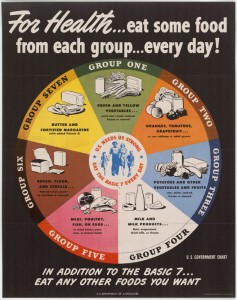Before the Food Pyramid Was a Pyramid or When Butter Was Its Own Food Group

Before food was organized into cohesive groups or placed into a pyramid or a plate, the United States Department of Agriculture introduced the Basic 7 Food Chart. Developed in 1943 as part of the nationwide implementation of wartime food rationing, the “Basic 7” stressed the need to maintain proper nutrition and healthy eating habits that were compatible with the limitation of certain foods. The Basic 7 food groups were:
- Green and yellow vegetables (some raw; some cooked, frozen or canned)
- Oranges, tomatoes, grapefruit (or raw cabbage or salad greens)
- Potatoes and other vegetables and fruits (raw, dried, cooked, frozen or canned)
- Milk and milk products (fluid, evaporated, dried milk, or cheese)
- Meat, poultry, fish, or eggs (or dried beans, peas, nuts, or peanut butter)
- Bread, flour, and cereals (natural whole grain, or enriched or restored)
- Butter and fortified margarine (with added Vitamin A)
The USDA stressed the importance of groups one through three not only for their nutritional value, but due to the fact that the foods included could all be grown to some degree in personal Victory Gardens, thus saving ration points for more limited items such as meat and sugar. It is also interesting that butter was a category unto itself.
Share your stories of the Basic 7 Food Chart at our Kitchen Memories site today.
Post by Anna Wysuph, Education Intern at The National WWII Museum
- Posted :
- Post Category :
- Tags : Tags: Food in WWII
- Follow responses to this entry through the RSS 2.0 feed. You can skip to the end and leave a response. Pinging is currently not allowed.




Leave a Reply